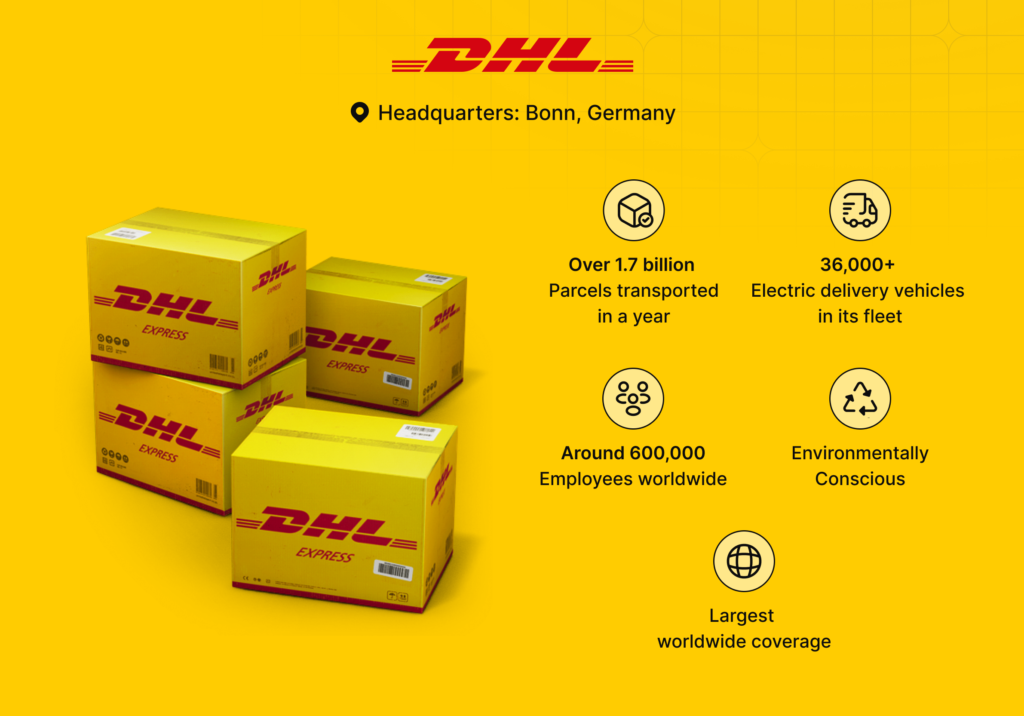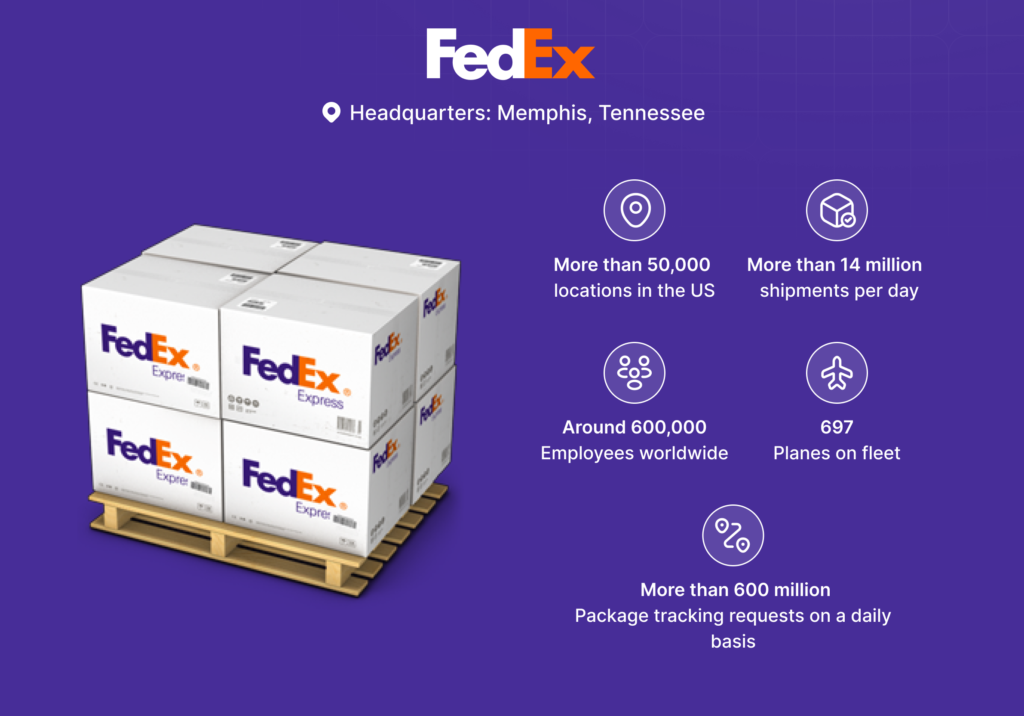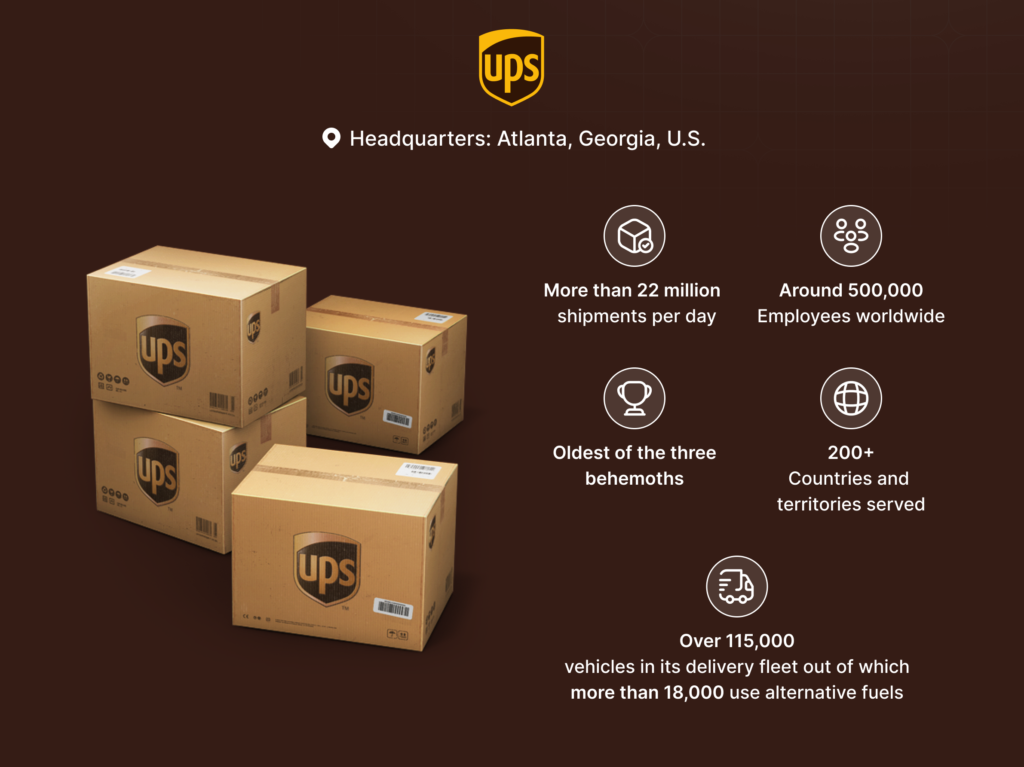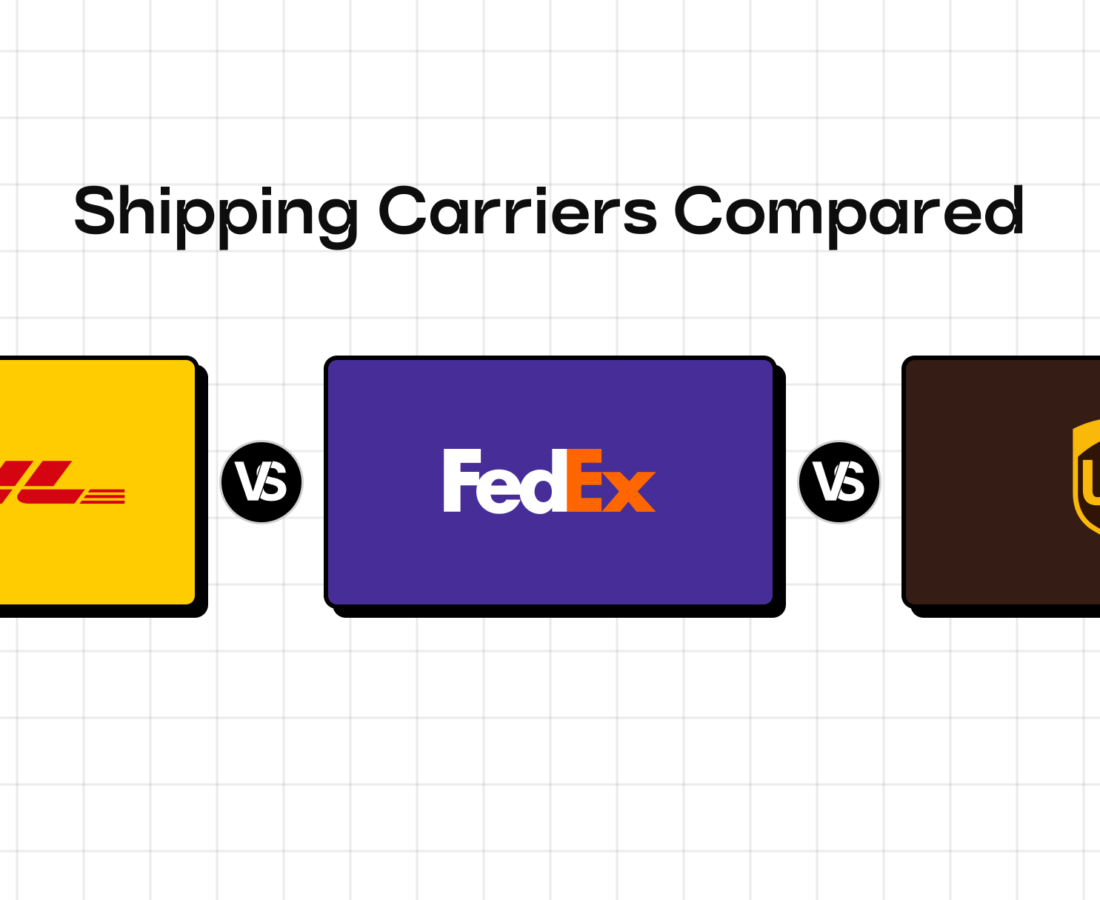Key Takeaways
Choosing between DHL, FedEx, and UPS depends on your specific shipping needs.
- DHL dominates international shipping with the fastest global delivery times and strongest presence in Europe and Asia.
- FedEx leads in express domestic services and offers the most extensive U.S. network with over 50,000 locations.
- UPS provides the most cost-effective ground shipping and handles the highest daily package volume at 24.3 million shipments.
Your best choice depends on whether you prioritize international reach, domestic speed, or budget-friendly ground services.
Introduction
Choosing a carrier from the list of companies is obviously a tedious process. Each carrier has its own set of strengths and weaknesses, and it is important to understand what they are and how well they suit your business needs.
To help you get better informed while making that decision, here’s an in-depth comparison of the three private giants, DHL, FedEx, and UPS — who have been in business for decades and have transported billions of parcels.
Although competing in the same line of business, DHL, FedEx, and UPS have a lot of things unique, particularly in line with their services, pricing, etc. By understanding these distinctive features, you can pick an option that aligns with your business’ shipping goals.
What Makes DHL, FedEx, and UPS Different from Each Other?
These three carriers might seem interchangeable, but they built their businesses differently, and those differences still matter today.
DHL

DHL started in 1969 and became the world’s largest logistics company by focusing on one thing: international shipping. With close to 600,000 employees and operations in over 220 countries, DHL has built its reputation on getting packages across borders fast.
Here’s what sets DHL apart. They’re headquartered in Germany, which gives them a natural advantage in European markets. Its international express services, like DHL Express 9:00, 10:30 and 12:00, offer time-specific delivery commitments that other carriers struggle to match globally. If you’re shipping from the US to Asia or Europe, DHL often gets there faster.
But there’s a catch. DHL’s domestic US network is limited. They focus almost exclusively on international shipments in and out of the country, not within it. So if you need reliable ground shipping across US states, DHL isn’t your answer.
FedEx

FedEx revolutionized overnight shipping when it launched in 1971. Today, they deliver 16.5 million packages daily to over 220 countries and operate more than 50,000 retail locations worldwide, including FedEx Office and Ship Centers.
FedEx built the biggest air fleet in the industry. This gives them an edge in express and overnight services, both domestic and international. Their FedEx Priority Overnight and FedEx 2Day services set the standard for time-definite shipping in the US.
Recently, FedEx launched Network 2.0, combining their Ground and Express networks. The goal is to streamline operations and reduce costs, though the transition has caused some service hiccups. What this means for you: potentially faster ground delivery as they optimize routes, but watch for temporary delays during the rollout.
UPS

UPS is the oldest of the three, starting back in 1907. They’ve grown into the largest package delivery company in the US by daily volume, moving 24.3 million packages every day. With over 500,000 employees and a presence in 220+ countries, UPS generates around $91 billion in annual revenue.
UPS dominates ground shipping. Their extensive truck fleet and optimized ground routes make them the go-to for cost-effective domestic deliveries. If you’re shipping heavy items or need reliable service without paying express rates, UPS Ground often wins on price and consistency.
They also excel at freight services. While FedEx and DHL offer freight options, UPS has the infrastructure and expertise for handling large shipments better than most.
How Do Their Service Options Compare?
All three carriers offer similar-sounding services, but the details matter when you’re choosing which one to use.
Domestic US Services
FedEx Domestic Services:
- FedEx SameDay and SameDay City for urgent local deliveries
- FedEx First Overnight, Priority Overnight, Standard Overnight (next business day with time commitments)
- FedEx 2Day A.M. and FedEx 2Day
- FedEx Express Saver (3 business days)
- FedEx Ground and Home Delivery (1-5 business days, most economical)
- FedEx SmartPost (economy option using USPS for final delivery)
UPS Domestic Services:
- UPS Next Day Air (Early, Regular, and Saver options)
- UPS 2nd Day Air (A.M. and regular)
- UPS 3 Day Select
- UPS Ground (1-5 business days, their bread and butter)
- UPS SurePost (economy option using USPS for the final mile)
DHL Domestic Services: Limited domestic-only options. DHL primarily focuses on international shipments in and out of the US. If you need domestic-only shipping, DHL isn’t competitive here.
International Services
DHL International Services:
- DHL Express Worldwide (fastest international option)
- DHL Express 9:00, 10:30, 12:00 (time-specific commitments)
- DHL Sameday Jetline and Sprintline
- DHL Express Easy
- DHL Globalmail Business
FedEx International Services:
- FedEx International Next Flight (most urgent)
- FedEx International First (morning delivery)
- FedEx International Priority (1-3 business days to most destinations)
- FedEx International Economy (4-6 business days, lower cost)
- FedEx International Ground (to Canada and Mexico)
UPS International Services:
- UPS Worldwide Express (1-3 business days)
- UPS Worldwide Expedited (2-5 business days)
- UPS Worldwide Saver (next business day)
- UPS Express Critical (for emergency shipments)
- UPS Standard (lower-cost international option)
Which Carrier Has the Best Delivery Speed?
Speed matters differently depending on where you’re shipping.
International Speed Comparison
DHL takes the crown for international shipping speed. Their DHL Express Worldwide service consistently delivers next-business-day to major global destinations. When you need a package in Singapore, Dubai, or Frankfurt by tomorrow morning, DHL is usually your best bet.
FedEx International Priority runs a close second, offering 1-3 business-day delivery to most international destinations. Their extensive air network and customs clearance expertise make them reliable for time-sensitive international shipments.
UPS Worldwide Express delivers in 1-3 business days internationally but tends to be slightly slower than DHL and FedEx on certain routes, particularly to Asia and remote locations.
Domestic Speed Comparison
For domestic US shipping, FedEx and UPS are nearly identical in speed for express services. Both offer next-day, 2-day, and 3-day options with similar delivery commitments.
Where UPS often edges ahead is in ground shipping consistency. Their optimized ground network has decades of route refinement, making UPS Ground slightly more predictable than FedEx Ground in many markets.
How Do Pricing Structures Stack Up?
Here’s where things get complicated, because all three carriers use similar pricing models but apply them differently.
Base Pricing Factors
All three carriers calculate rates based on:
- Package weight
- Dimensional weight (length x width x height/divisor)
- Distance (zone-based pricing)
- Service level (overnight costs more than ground)
- Delivery type (residential vs. commercial)
The dimensional weight divisor matters more than you think. Both FedEx and UPS use a divisor of 139 for most services, which means lightweight but bulky packages get charged based on size rather than actual weight. DHL uses a similar dimensional pricing for international shipments.
Surcharges Add Up Fast
Beyond base rates, surcharges can increase your actual cost by 20-40%. Common ones include:
- Residential delivery surcharges (adding $4-6 per package)
- Fuel surcharges (fluctuating based on market rates)
- Remote area fees
- Address correction charges
- Additional handling for oversized packages
- Peak season surcharges during holidays
FedEx and UPS have nearly identical surcharge structures. DHL’s surcharges tend to be more complex for international shipments due to customs and cross-border factors.
Volume Discounts Change Everything
Here’s what carriers don’t advertise: published rates are just the starting point. If you’re shipping significant volume, you can negotiate substantial discounts.
UPS and FedEx account managers have the authority to offer discounts ranging from 10% to 70% off published rates, depending on your volume and service mix. DHL offers similar discounts for international shippers.
The key is understanding your shipping data before negotiating. Know your average package weight, typical destinations, and monthly volume. Carriers give better deals when you can show consistent shipping patterns.
Cost Comparison by Use Case
For domestic ground shipping: UPS typically offers the most competitive rates, especially for heavier packages. Their ground network efficiency translates to better pricing.
For domestic express: FedEx and UPS are usually within a few dollars of each other. Shop both based on your specific lanes and service levels.
For international shipping: DHL often costs more but delivers faster. FedEx and UPS offer economy international options that can be 30-40% cheaper than DHL Express, though with longer transit times.
What About Reliability and On-Time Performance?
Carriers publish their own performance metrics, but real-world experience often tells a different story.
Domestic Reliability
UPS maintains the strongest domestic reliability record, particularly for ground services. Their mature network and route optimization results in fewer delays and exceptions. According to industry tracking data, UPS Ground averages around 95% on-time performance for standard deliveries.
FedEx Ground has historically lagged slightly behind UPS but has improved with the Network 2.0 consolidation. Its express services (Priority Overnight, etc.) remain highly reliable, typically exceeding 98% on-time performance when weather and other factors don’t interfere.
International Reliability
DHL leads in international reliability, especially to Europe, Asia, and emerging markets. Their dedicated international infrastructure and customs expertise result in fewer delays at borders. For businesses shipping regularly to international markets, DHL’s consistency often justifies their higher rates.
FedEx and UPS perform similarly for international shipments to major markets. However, for shipments to secondary cities or remote locations, DHL’s network advantage becomes clear.
The Money-Back Guarantee Trap
All three carriers offer service guarantees that promise refunds for late deliveries. Sounds great, right? Here’s the catch.
The fine print includes dozens of exceptions that void your refund eligibility:
- Weather delays
- Natural disasters
- Peak season periods (when delays are most common)
- Incorrect addresses
- Customs delays
- Recipient unavailable
Many businesses discover they signed contracts that waived their money-back guarantee in exchange for rate discounts. Always check whether your agreement includes guarantee waivers.
Even when eligible, filing refund claims can be time-consuming. You typically have 15-30 days to file, and carriers reject claims for minor technicalities. This is where tools like LateShipment.com can help in tracking all your shipping invoices, identifying late deliveries, and filing refund claims on your behalf, helping you recover money you’d otherwise lose.
Which Carrier Has Better Tracking and Technology?
Modern shipping requires more than just moving boxes. You need visibility, proactive notifications, and data.
Tracking Capabilities
All three carriers offer real-time tracking through websites, mobile apps, and APIs. But the quality of tracking data varies.
FedEx provides the most detailed tracking updates, with frequent scans throughout the shipping journey. Their tracking shows not just current location but estimated delivery times that update dynamically based on actual transit progress.
UPS tracking is equally comprehensive for express services but can be less granular for ground shipments, with longer gaps between scans.
DHL international tracking excels at providing customs clearance updates, which is crucial when you need to know if a package is stuck at a border. Their domestic tracking (for the limited domestic services they offer) is less detailed.
API and Integration Options
All three carriers provide APIs for integrating shipping into your e-commerce platform or order management system. The quality and documentation vary:
FedEx APIs are well-documented but can be complex to implement. They support comprehensive functionality, including rating, label generation, tracking, and address validation.
UPS APIs are similarly robust with good documentation. Many developers find UPS APIs slightly easier to implement than FedEx.
DHL APIs work well for international shipping but have limitations for domestic operations. Their documentation is adequate but not as comprehensive as FedEx or UPS.
How Do Their Customer Service Experiences Compare?
When something goes wrong, you need responsive support that actually solves problems.
Response Times and Availability
All three carriers offer 24/7 customer service through phone, chat, and email. But availability doesn’t equal effectiveness.
UPS customer service gets mixed reviews. Their phone support can involve long hold times, and representatives often have limited authority to resolve complex issues. However, if you have an account manager, they can often expedite solutions.
FedEx customer service is generally more responsive, with shorter hold times and representatives who have more problem-solving authority. Their online chat support is particularly effective for tracking and delivery updates.
DHL customer service for international shipping is strong, with knowledgeable representatives who understand customs and cross-border complications. Their domestic customer service is less developed due to their limited US-only operations.
Claims and Dispute Resolution
Filing claims for lost or damaged packages is never fun, but the process differs significantly between carriers.
FedEx claims must be filed within 60 days for domestic shipments and 21 days for international shipments. You need proof of value, photos of damage, and the tracking number. Processing typically takes 7-21 business days. Their online claims portal is user-friendly.
UPS claims must be filed within 5 months online or 9 months through customer service. The process is similar to FedEx, requiring documentation and photos. UPS tends to be more stringent in approving claims, often requesting additional documentation.
DHL claims for international shipments can be complex due to varying regulations by country. Processing times vary widely depending on the origin and destination countries.
What Are the Best Use Cases for Each Carrier?
Instead of asking which carrier is “best,” your question should ask which carrier fits your specific shipping profile.
Choose DHL if:
You ship primarily international packages to Europe, Asia, or emerging markets. DHL’s speed and reliability for cross-border shipments justify their premium pricing.
You need guaranteed time-specific delivery internationally (9:00 AM, 10:30 AM, 12:00 PM commitments).
You regularly deal with complex customs requirements and need a carrier with deep international expertise.
You value delivery speed over cost for international shipments.
Choose FedEx if:
You need reliable domestic overnight and 2-day services. FedEx Express services set the standard for time-definite shipping.
You ship to residential addresses frequently and want a carrier with an extensive retail network for customer pickups.
You need a balance of domestic and international capability without specializing in either.
You value detailed tracking and proactive notifications.
Choose UPS If:
Ground shipping makes up most of your volume. UPS Ground offers the best combination of reliability and cost-effectiveness for domestic deliveries.
You ship heavier packages or freight regularly. UPS excels at handling larger shipments.
You want the most predictable and consistent service for standard deliveries.
Cost is a primary concern and you’re willing to trade some speed for savings.
How Should You Negotiate Your Shipping Contract?
Don’t just accept the rates carriers quote. Negotiation is expected, and the savings can be substantial.
Know Your Data Before Negotiating
Gather at least three months of shipping data showing:
- Total package volume by service type
- Average package weight and dimensions
- Top destination zones
- Residential vs. commercial delivery split
- Current costs and surcharges
Carriers give better discounts when you can demonstrate consistent volume and predictable shipping patterns.
Negotiable Elements Beyond Base Rates
Focus on these areas for maximum savings:
- Minimum charge waivers: Eliminate or reduce minimum charges for light packages
- Residential surcharge reductions: This alone can save 10-15% on B2C shipping costs
- Fuel surcharge caps: Lock in maximum fuel surcharge percentages
- Dimensional weight divisor increases: Negotiate to use 166 instead of 139
- Address correction fee waivers: Eliminate charges for minor address fixes
- Money-back guarantee preservation: Don’t waive this unless you’re getting substantial discounts
Leverage Competition
Never negotiate with just one carrier. Get quotes from at least two carriers simultaneously. FedEx and UPS know they’re competing for your business, and that competition works in your favor.
If you’re currently shipping with UPS, approach FedEx with your volume data. If you’re with FedEx, approach UPS. The incumbent carrier often matches competitive offers to retain your business.
Contract Terms to Watch
Auto-renewal clauses: Many contracts automatically renew with rate increases. Negotiate shorter terms (1-2 years) with opt-out provisions.
Rate increase caps: Limit annual rate increases to specific percentages (typically 4-5%).
Volume commitments: Avoid hard volume commitments if possible. If required, negotiate them as low as you can consistently meet.
Review periods: Build in quarterly or semi-annual review periods to adjust rates based on your changing shipping profile.
Common Mistakes That Cost You Money
After working with hundreds of shippers, we see the same costly mistakes repeatedly.
Ignoring Surcharges in Decision-Making
Base rates tell only part of the story. A carrier offering 20% off base rates but charging full residential surcharges might cost more than a carrier with 10% off base rates but reduced surcharges.
Calculate total landed cost per package, including all surcharges, before committing to a carrier.
Failing to Audit Shipping Invoices
Carrier billing errors are common. Address correction charges for correct addresses, duplicate charges, incorrect weights, wrong zones, and improper surcharges can inflate your costs by 5-15%.
Most businesses lack the time to audit every invoice manually. Shipping audit tools can automatically identify overcharges and file refund claims, typically recovering 2-5% of total shipping spend.
Sticking with One Carrier for Everything
Why use UPS for both overnight and ground? FedEx might offer better overnight rates while UPS offers better ground rates. Multi-carrier shipping lets you use each carrier’s strengths.
The complexity of managing multiple carriers is minimal with modern shipping platforms that integrate all carriers into a single interface.
Not Tracking Service Failures
Late deliveries cost money through the money-back guarantee. But you need to track and file claims within tight deadlines.
Most businesses discover they’re losing hundreds or thousands monthly in eligible refunds they never claimed. Automated tracking and claims tools recover this lost revenue without manual effort.
How Do You Know When to Switch Carriers?
Don’t stay with a carrier just because you’ve always used them. Markets change, your business evolves, and carrier performance shifts.
Warning Signs It's Time to Shop Around
Consistent late deliveries: If more than 5% of shipments arrive late, that’s a problem. Track your on-time performance by carrier and route.
Rising costs without improved service: Annual rate increases are expected, but if your costs are rising faster than industry averages (typically 4-6% annually) without service improvements, shop competitors.
Poor problem resolution: If filing claims or resolving delivery issues consistently takes multiple contacts and weeks, that’s not normal. Better carriers resolve most issues within days.
Service area gaps: If your carrier can’t reliably serve areas where you’re growing sales, that’s a strategic problem requiring a carrier change or addition.
Final Thoughts
Choosing between DHL, FedEx, and UPS isn’t about finding the objectively best carrier. It’s about finding the best fit for how and where you ship.
DHL wins for international speed and global reach. FedEx excels at domestic express and offers the best balance of capabilities. UPS dominates cost-effective ground shipping and handles the highest volumes.
Most businesses end up using at least two carriers, leveraging each one’s strengths for different shipping scenarios. That’s not complexity, that’s smart shipping strategy.
The real cost of poor carrier choice isn’t just the shipping rates you pay. It’s the customers you lose when deliveries consistently arrive late, the refunds you never claim for service failures, and the opportunities you miss in markets your carrier doesn’t serve well.
Start by analyzing where you ship, how fast customers need delivery, and what you’re currently paying. Then match those requirements against each carrier’s strengths. The right choice will be clear.
FAQ
Which carrier is cheapest for domestic shipping?
UPS typically offers the lowest rates for domestic ground shipping, especially for packages over 5 pounds. For lightweight packages under 2 pounds, carriers like USPS often beat all three private carriers. For express services (overnight, 2-day), FedEx and UPS are usually within a few dollars of each other, so compare both for your specific lanes.
Can I use multiple carriers simultaneously?
Yes, and you probably should. Most successful e-commerce businesses use 2-3 carriers, selecting the best option for each shipment based on destination, speed requirements, and cost. Modern shipping platforms and multi-carrier software make managing multiple carriers as simple as using one.
How do I get better shipping rates?
Start by gathering 3-6 months of shipping data, then request quotes from multiple carriers simultaneously. Negotiate not just base rates but also surcharge reductions, especially for residential delivery and fuel surcharges. Consider joining a shipping cooperative or using a shipping platform that has pre-negotiated carrier rates.
What happens if my DHL/FedEx/UPS package arrives late?
All three carriers offer money-back guarantees for late deliveries on select services, but exclusions apply. You typically need to file claims within 15-30 days of the scheduled delivery date. Weather, peak seasons, and many other factors can void your eligibility. Check your contract to confirm your guarantee wasn’t waived.
How do I handle international customs issues?
Work with carriers that provide customs brokerage services. DHL typically handles customs clearance most smoothly due to its international focus. Ensure you provide complete and accurate customs documentation, including harmonized tariff codes, accurate value declarations, and clear product descriptions. Incomplete documentation causes most customs delays.
How often should I review my shipping contracts?
Review your shipping performance and costs quarterly. Renegotiate contracts annually or whenever your shipping volume or patterns change significantly. Major business changes like new product lines, entering new markets, or sales growth above 25% annually all warrant immediate contract review.
What's the difference between residential and commercial delivery?
Residential deliveries go to homes and typically include a $4-6 surcharge per package. Commercial deliveries go to businesses during business hours. The distinction matters because residential surcharges can add 10-20% to total shipping costs. Some carriers classify apartment complexes as residential regardless of whether businesses operate there.












